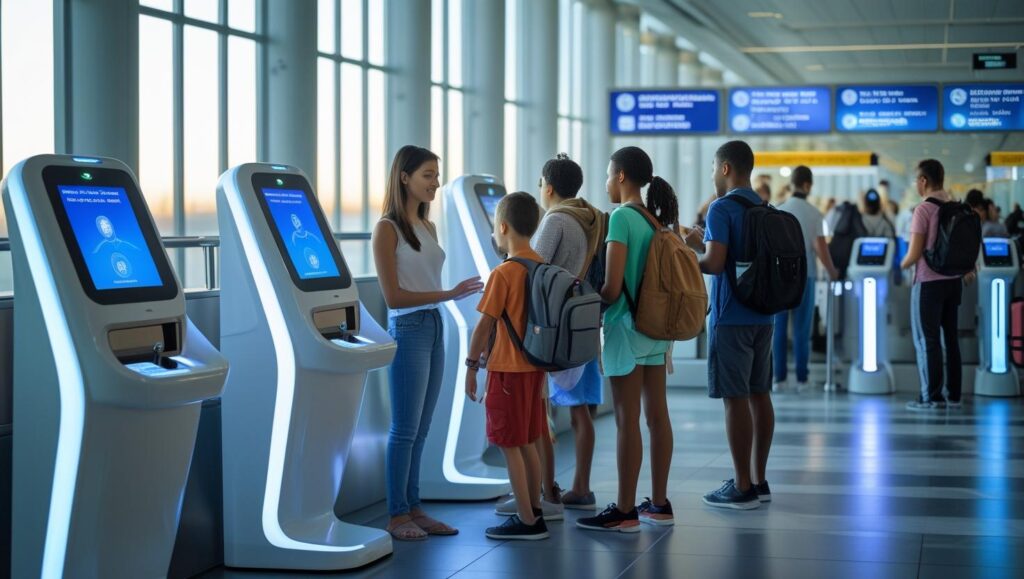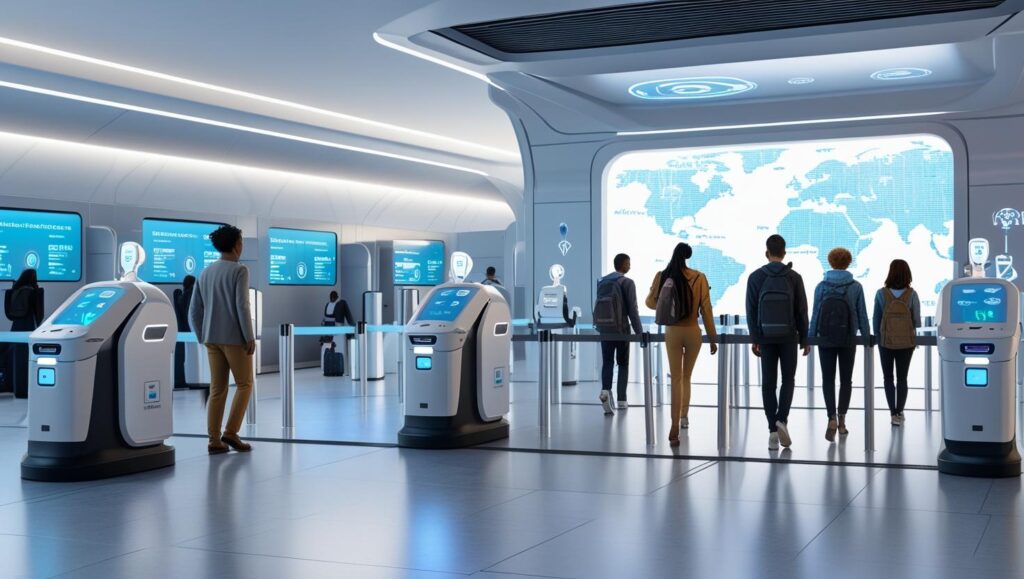Artificial Intelligence (AI) is revolutionizing industries worldwide, and the border control sector is no exception. The integration of AI technologies is reshaping how nations secure their borders, manage immigration, and combat illegal activities. From advanced surveillance systems to biometric authentication and predictive analytics, the AI impact in the future of border control industry is profound, offering solutions that enhance security, streamline operations, and improve decision-making. As global travel and trade continue to grow, the demand for efficient and secure border management systems is at an all-time high. This article explores the multifaceted role of AI in transforming the border control industry, delving into its applications, benefits, challenges, and future potential.
The automated border control market is projected to be valued at USD 2.56 billion in 2025 and reach USD 5.03 billion by 2030, growing at a CAGR of 14.4% from 2025 to 2030.

The Growing Need for Advanced Border Control Solutions in a Globalized World
Globalization has led to an unprecedented increase in cross-border movement, with millions of people and goods crossing international boundaries daily. This surge has placed immense pressure on border control agencies to maintain security while ensuring seamless travel and trade. Traditional methods, reliant on manual checks and human oversight, are increasingly inadequate in addressing modern challenges such as terrorism, human trafficking, and smuggling. The AI impact in the future of border control industry lies in its ability to address these challenges through automation, data analysis, and real-time decision-making, enabling agencies to stay ahead of evolving threats while improving operational efficiency.
Key AI Technologies Driving Innovation in the Border Control Industry
AI encompasses a range of technologies that are being tailored to meet the unique needs of border control. These technologies are transforming how agencies monitor, process, and secure borders. Below are some of the most impactful AI-driven innovations shaping the AI impact in the future of border control industry:
- Facial Recognition and Biometric Authentication: AI-powered biometric systems, such as facial recognition and iris scanning, enable rapid and accurate identity verification, reducing wait times at border checkpoints.
- Predictive Analytics for Risk Assessment: Machine learning models analyze historical and real-time data to predict potential security risks, such as identifying high-risk travelers or cargo.
- Automated Surveillance Systems: AI-driven drones and cameras equipped with computer vision monitor vast border areas, detecting suspicious activities in real time.
- Natural Language Processing (NLP): NLP tools process multilingual data, aiding in the analysis of travel documents and communication intercepts.
These technologies collectively enhance the ability of border control agencies to operate efficiently and securely, making the AI impact in the future of border control industry a cornerstone of modern border management.
Enhancing Border Security Through AI-Powered Surveillance and Monitoring Systems
AI-powered surveillance systems are at the forefront of securing national borders. Traditional surveillance methods, such as manned patrols and static cameras, are limited in scope and scalability. AI-driven solutions, including drones, satellites, and smart cameras, provide continuous monitoring of vast and remote border areas. These systems use computer vision to detect anomalies, such as unauthorized crossings or suspicious vehicles, and alert authorities in real time. By integrating machine learning, these systems improve over time, learning to distinguish between normal and threatening activities. The AI impact in the future of border control industry is evident in how these tools reduce the reliance on human resources while increasing the accuracy and speed of threat detection.
Streamlining Immigration Processes with AI-Driven Biometric Authentication
Biometric authentication is one of the most significant advancements in border control, driven by AI. Systems that utilize facial recognition, fingerprint scanning, and iris recognition are now commonplace at airports and border checkpoints. These systems verify identities quickly and accurately, reducing the risk of identity fraud and human error. For instance, AI-powered kiosks at airports allow travelers to scan their passports and faces, automating the entry process and reducing wait times. The AI impact in the future of border control industry lies in its ability to create seamless yet secure immigration processes, balancing traveler convenience with stringent security measures.
Predictive Analytics: Anticipating and Mitigating Border Security Risks
Predictive analytics is a game-changer for border control agencies. By analyzing vast amounts of data—such as travel patterns, criminal records, and global threat intelligence—AI models can identify potential risks before they materialize. For example, machine learning algorithms can flag high-risk travelers or shipments based on historical data and behavioral patterns. This proactive approach allows authorities to allocate resources effectively and prevent incidents. The AI impact in the future of border control industry is particularly notable in how predictive analytics shifts border control from reactive to proactive strategies, enhancing overall security.
AI in Cargo and Trade Management: Ensuring Secure and Efficient Cross-Border Commerce
The global trade industry relies heavily on efficient border processes to minimize delays and costs. AI is transforming cargo management by automating inspections and detecting illicit goods. Machine learning algorithms analyze X-ray images of cargo containers to identify hidden contraband, such as drugs or weapons, with greater accuracy than human inspectors. Additionally, AI systems track supply chain data to ensure compliance with international regulations. By reducing manual inspections and improving detection rates, the AI impact in the future of border control industry supports secure and efficient cross-border commerce, benefiting economies worldwide.
The Role of AI in Combating Human Trafficking and Smuggling at Borders
Human trafficking and smuggling are persistent challenges for border control agencies. AI technologies are proving instrumental in addressing these issues by analyzing patterns and identifying suspicious activities. For instance, AI systems can cross-reference travel data, social media activity, and financial transactions to detect networks involved in trafficking or smuggling. Drones and surveillance cameras equipped with AI can monitor remote border areas where such activities are prevalent. The AI impact in the future of border control industry includes empowering agencies to dismantle criminal networks and protect vulnerable populations more effectively.
Ethical Considerations and Challenges in Implementing AI in Border Control Systems
While AI offers immense potential, its implementation in border control raises ethical and operational challenges. Privacy concerns are paramount, as biometric data collection and surveillance systems can infringe on individual rights if not properly regulated. Bias in AI algorithms is another issue, as models trained on skewed data may lead to unfair profiling or discrimination. Additionally, the high cost of deploying AI systems can be a barrier for some nations. Addressing these challenges is critical to ensuring that the AI impact in the future of border control industry is positive and equitable, balancing security with ethical considerations.
The Future Potential of AI in Transforming Border Control Operations Globally
The future of AI in border control is poised for exponential growth. Emerging technologies, such as quantum computing and advanced neural networks, could further enhance AI’s capabilities in data processing and threat detection. Collaborative AI systems, where multiple countries share data and insights, could lead to globalized border security frameworks. Additionally, AI-driven automation could reduce the need for physical border checkpoints, creating “smart borders” that operate seamlessly. The AI impact in the future of border control industry will likely redefine how nations approach security, making borders both more secure and more accessible.

Overcoming Implementation Challenges to Maximize AI’s Impact in Border Control
To fully realize the AI impact in the future of border control industry, agencies must address implementation challenges systematically. Investing in robust cybersecurity measures is essential to protect sensitive data from breaches. Training personnel to work alongside AI systems ensures effective human-machine collaboration. Additionally, international cooperation is vital for standardizing AI protocols and sharing best practices. By overcoming these hurdles, border control agencies can harness AI’s full potential to create secure, efficient, and ethical systems.
Download PDF Brochure @ https://www.marketsandmarkets.com/pdfdownloadNew.asp?id=24899883
Embracing AI for a Secure and Efficient Border Control Future
The AI impact in the future of border control industry is transformative, offering solutions that enhance security, streamline processes, and address global challenges. From biometric authentication to predictive analytics and automated surveillance, AI is redefining how borders are managed. While challenges such as privacy concerns and implementation costs remain, the benefits of AI far outweigh the drawbacks. As technology continues to evolve, border control agencies must embrace AI to stay ahead of emerging threats and create a future where borders are both secure and accessible. By investing in AI-driven solutions, nations can build smarter, safer, and more efficient border control systems that meet the demands of a globalized world.
Explore In-Depth Semiconductor & Electronics Market Research –https://www.marketsandmarkets.com/semiconductorand-electonics-market-research-87.html
FAQs
1. How is AI currently used in border control?
AI is used in border control for biometric authentication (e.g., facial recognition), predictive analytics for risk assessment, automated surveillance, and cargo inspection. These technologies enhance security and efficiency at border checkpoints.
2. What are the benefits of AI in the border control industry?
AI improves security through real-time threat detection, reduces processing times with automation, enhances accuracy in identity verification, and supports efficient trade by streamlining cargo inspections.
3. What challenges does AI face in border control implementation?
Challenges include privacy concerns, potential biases in AI algorithms, high implementation costs, and the need for robust cybersecurity to protect sensitive data.
4. How does AI help combat human trafficking at borders?
AI analyzes travel patterns, social media, and financial data to identify trafficking networks. Surveillance systems, such as AI-powered drones, monitor remote areas to detect suspicious activities.
5. What is the future of AI in the border control industry?
The future includes advanced AI models, quantum computing, and globalized “smart borders” that reduce physical checkpoints while enhancing security through real-time data sharing and automation.
See The Latest Semiconductor Reports:
Valve Positioner Market Size, Share & Trends : https://www.marketsandmarkets.com/Market-Reports/valve-positioner-market-138950854.html
Environmental Remediation Market Size, Share & Trends : https://www.marketsandmarkets.com/Market-Reports/environmental-remediation-market-93290334.html
UV LED Market Size, Share & Trends: https://www.marketsandmarkets.com/Market-Reports/uv-led-market-143107738.html
Control Valve Market Size, Share & Trends: https://www.marketsandmarkets.com/Market-Reports/control-valves-market-111759647.html
GPU Server Market Size, Share & Trends: https://www.marketsandmarkets.com/Market-Reports/gpu-server-market-224437074.html
